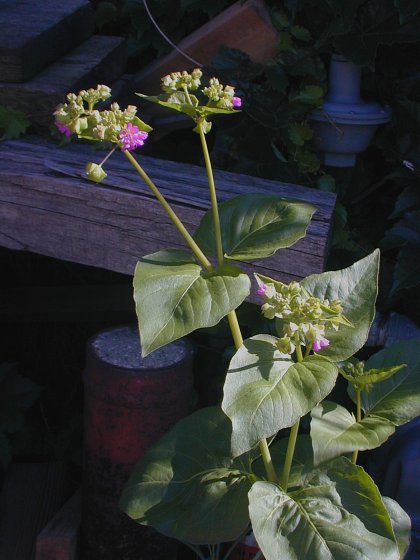Description: This herbaceous perennial plant is about 2-4' tall, branching occasionally. The stems are glabrous and light green; they are often angular below, becoming more round above. The dark green opposite leaves are up to 4" long and 3" across. They are cordate (somewhat triangular-shaped) and hairless, with smooth margins and short petioles. Some of the upper leaves near the flowers are much smaller and lanceolate. The upper stems terminate in clusters of magenta flowers on long stalks. Usually, there are a few hairs on these stalks and the pedicels of the flower clusters. A cluster of 3-5 flowers develop within a surrounding green bract with 5 lobes; this bract has the appearance of a calyx. These flowers are trumpet-shaped and span about ½" across, or slightly less. There are no petals; instead, a tubular calyx with 5 notched lobes functions as a corolla. At the center of each flower are 3-5 exerted stamens with yellow anthers. The blooming period is usually during the early summer and lasts about a month. There is little or no floral fragrance. The flowers typically open during the late afternoon, remain open at night, and close during the morning. The greyish brown seed is up to 3/8" (10 mm.) long and pubescent; it has 5 ribs. The root system consists of a thick dark taproot that is fleshy or woody. This plant spreads by reseeding itself.

Cultivation:
The
preference is full sun and mesic to dry conditions; partial sun is also
tolerated. This plant commonly grows in poor soil that has a high
content of clay, sand, or gravelly material. It will also grow in
fertile loam, but suffers from the competition of neighboring plants.
Foliar disease is not usually troublesome. It is easy to start plants
from seeds.
Range & Habitat:
Wild Four-O'Clock occurs in nearly every county of Illinois; it is a
common plant (see Distribution
Map). This plant is adventive from areas that lie west of of
the state. Habitats include dry prairies, pastures, abandoned
fields, grassy roadsides, rocky banks along ditches, areas along
railroads (including the ballast), and miscellaneous waste areas. This
plant is particularly common along railroads. It has a strong
preference for disturbed areas.

Faunal Associations: The flowers are visited primarily by long-tongued bees, short-tongued bees, and moths. These insects seek nectar primarily, although the short-tongued bees collect pollen. It is possible that the Ruby-Throated hummingbird may visit the flowers as well. The species Catorhintha mendica (Wild Four-O'Clock Bug) is a specialist feeder on this plant and other Mirabilis spp. Another specialist is Heliodines nyctaginella (Four-O'Clock Moth); the caterpillars of this species feed on the foliage of this and other plants in the genus. Wild Four-O'Clock tends to increase in areas disturbed by livestock; it is unclear if these animals eat this plant. Deer reportedly avoid it. The seeds and roots are known to be poisonous, although pigs may dig up the roots and eat them.

Photographic
Location:
The photographs were taken along a railroad track in Champaign-Urbana,
Illinois.
Comments:
This is the most widespread Four-O'Clock species in Illinois that is
from North America. The commonly cultivated garden plant by the same
name is from South America; it is non-hardy. There are a few wild Mirabilis
spp. in the Chicago area that are adventive from the west.
They usually have more narrow leaves, hairier stems, and flowers with
paler colors. In some of the Great Plains states, the Wild Four-O'Clock
can have pale yellow flowers, but this color form doesn't appear to
occur in Illinois.